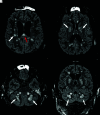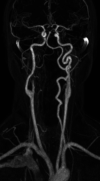COVID-19 Neurologic Complication with CNS Vasculitis-Like Pattern
- PMID: 32554425
- PMCID: PMC7658880
- DOI: 10.3174/ajnr.A6651
COVID-19 Neurologic Complication with CNS Vasculitis-Like Pattern
Abstract
Coronavirus disease 2019 (COVID-19) is a viral infection caused by the Severe Acute Respiratory Syndrome coronavirus 2 (SARS-CoV-2), which spreads rapidly from person to person and manifests in most symptomatic patients as a respiratory illness, similar to prior SARS viruses. Neurologic manifestations of COVID-19 are uncommon; those so far reported include encephalopathy, stroke from large-vessel occlusion, and polyneuropathy. We report a unique neurologic complication of COVID-19 in a patient who had extensive cerebral small-vessel ischemic lesions resembling cerebral vasculitis in a characteristic combined imaging pattern of ischemia, hemorrhage, and punctuate postcontrast enhancement. Also, a characteristic lower extremity skin rash was present in our patient. Our observation lends support to the increasingly suspected mechanism of "endotheliitis" associated with this novel coronavirus.
© 2020 by American Journal of Neuroradiology.
Figures






Comment in
-
Reply.AJNR Am J Neuroradiol. 2021 Jan;42(2):E5. doi: 10.3174/ajnr.A6944. Epub 2021 Jan 14. AJNR Am J Neuroradiol. 2021. PMID: 33446497 Free PMC article. No abstract available.
-
COVID-19 Related Central Nervous System Vasculopathy: Beyond Vasculitis.AJNR Am J Neuroradiol. 2021 Jan;42(2):E4. doi: 10.3174/ajnr.A6913. Epub 2021 Jan 14. AJNR Am J Neuroradiol. 2021. PMID: 33446498 Free PMC article. No abstract available.
References
-
- World Health Organization. Coronavirus disease 2019. 2020. April 30 https://www.who.int/emergencies/diseases/novel-coronavirus-2019. Accessed April 30, 2020
-
- COVID-19 CORONAVIRUS PANDEMIC. May 20 2020. https://www.worldometers.info/coronavirus. Accessed April 30, 2020
-
- 2019–20 Coronavirus Pandemic. Public Health Emergency. Coronavirus https://www.who.int/emergencies/diseases/novel-coronavirus-2019. Accessed April 30, 2020
-
- US Centers for Disease Control and Prevention. Symptoms of Novel Coronavirus (2019-nCoV). February 10, 2020. https://www.cdc.gov/coronavirus/2019-ncov/symptoms-testing/symptoms.html. Accessed April 30, 2020
Publication types
MeSH terms
LinkOut - more resources
Full Text Sources
Miscellaneous
